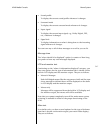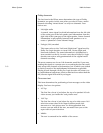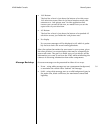
5-54
Menu System Mark Levinson
• cap Toggles the characters between capital and small letters
• save Saves the current Name Line and returns to the menu
• quit Returns to the menu without saving the Name Line
• ––> Moves the cursor one space to the right
• <–– Moves the cursor one space to the left.
4. Repeat steps 1 - 3 to fill in the name.
5. To end the editing session, use the save or quit operations. The
menu button also quits.
Default Video System
The Nº40 generates its on-screen menus and messages in a format
that is compatible with the type of video signal you are watching,
whether NTSC (525 lines/60 Hz) or PAL (625 lines/50 Hz). However,
there may be times when you have not selected any video signal (as
when listening to a CD player, perhaps), yet would like to be able to
access menus and messages from the system.
By specifying the default video system for the Nº40, you are in
effect telling the Nº40 what your preference is for displaying menus
and messages on those occasions when there is no currently-
selected video signal.
If you have a multi standard monitor that can display both NTSC
and PAL, you can pick either. If your video system is not multi stan-
dard, pick either NTSC or PAL, according to what your television
can display.
Component Options
There is one option for the main zone component video outputs:
component type.
“Component video” normally refers to a three-wire video signal
that contains the luminance signal (brightness; the “black and
white” portion of the picture) on one cable, and two chroma
signals (color difference; the color information in the picture) on
two additional cables.
This sort of “component” video is variously described as “compo-
nent,” “YUV,” “YPbPr,” “YCrCb,” and even “Y, R-Y, B-Y.” For your
purposes, consider these designations to be interchangeable. (The
differences between them are mostly of interest to engineers, and
several companies use the wrong designations anyway.)
Thus if your video display has a “component” input that you want
to use with these main video outputs, select the “YPbPr” item on
the component type menu, and connect the main outputs from the
No40 accordingly, as per their labelling.
The other component option is RGB. The 480i RGB standard is used
primarily in Europe, as part of the SCART interconnection standard


















